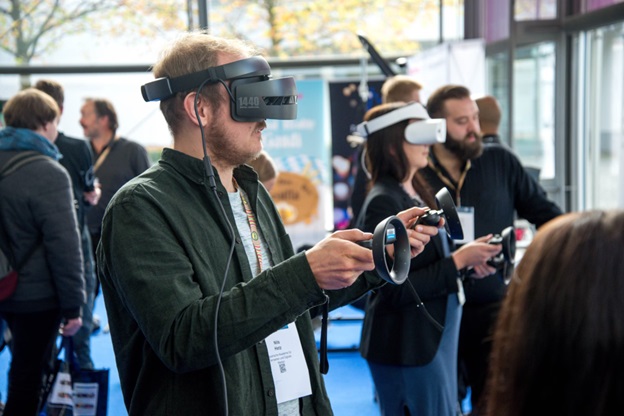According to the Center for Disease Control, approximately 6 million people in the United States are affected by vision loss, and 1 million people are characterized as legally blind. People of all ages, genders, and backgrounds are impacted by vision and eyes disorders, but certain accommodations can be made to ensure that individuals who are blind or have low vision are still able to engage fully and equally with the world around them.
Audio description is one such accommodation that can be used to deliver more equitable content experiences to audience members with vision-related disabilities. Audio-described video content is more readily accessible to individuals who are blind or otherwise impacted by vision loss. Let’s discuss some of the basics of audio description and explore how this assistive technology can help creators offer more engaging, equitable experiences to all audience members.
Introduction to Audio Description
Audio description is a type of accessibility technology that is used to make video and other visual content more inclusive of audience members who are blind or have low vision. Audio description uses recorded audio narrations to describe certain visual elements of a video while the content plays.
Most audio description services utilize two standard styles of descriptive narration: standard audio description and extended audio description. Standard audio description inserts the recorded narration into existing pauses in a video so as not to overlap with any important audio elements. The descriptions used in standard audio description tend to be more succinct so they can fit comfortably within the video’s pauses.
Extended audio description, on the other hand, offers longer, more complex descriptions of visual elements for a more comprehensive media experience. Because these descriptions tend to be lengthier than standard audio descriptions, producers may need to insert or lengthen pauses to ensure the audio description does not distract from the video’s existing audio. In the next section, we will explore how both of these audio description approaches can offer more engaging content experiences to all audience members.

Benefits of Audio Description Services
Audio description is most often used to make visual content more inclusive for audience members with vision and eye disorders. Audio description provides an alternative means of sharing information that was originally conveyed via certain visual elements of a video. For example, a descriptive narration track can be used to describe certain nonverbal cues like facial expressions and gestures.
Audio description can also be a valuable tool for supporting audience members with certain neurodivergent conditions, such as those with autism spectrum disorder (ASD). Some individuals with ASD need additional support to properly interpret certain visual cues. Viewers with ASD can benefit from the presence of an audio description track because the narration often clarifies the underlying meaning of visual cues like hand gestures and body language.
Including accurate and comprehensive audio description of video content can provide a richer and more engaging media experience to a wide range of viewers, not just those who are blind or have low vision. Furthermore, offering audio description of your video content is a great way of supporting accessibility standards like the ADA and WCAG that require certain accommodations be made for individuals with disabilities.
Types of Audio Description Services
Audio description tracks can be added to a wide variety of media, and many digital media platforms offer audio description capabilities. There are three common approaches to audio description that can be employed depending upon the specifications of a particular media project and its audience. These approaches include:
- Pre-recorded Audio Description: This style is used to support pre-recorded video content that is being shared with a broad audience. Pre-recorded audio description tracks are recorded separately from the original audio and video and incorporated into the content after the fact.
- Live Audio Description: Live audio description is used to provide real-time support for viewers with disabilities and specific learning needs. Trained describers will provide users with descriptive narration in real time as the video content is played or streamed.
- Integrated Audio Description: Integrated audio description is meticulously crafted to weave the descriptions of visual elements into the actual script of a video. Integrated audio description is often used in video content that is explicitly meant for audiences affected by vision loss.
Audio description can be an incredibly versatile accessibility tool for creators looking to offer more inclusive and engaging viewing experiences. It is important to carefully consider the needs of your project and its target audience to select the right audio description approach for your visual media.

Implementation of Audio Description Services
Audio description can be used to support a wide range of media projects and other experiences. Most consumers are familiar with audio description as it pertains to movies and TV shows. Many popular streaming services offer audio description in addition to other accessibility tools like closed captioning, which makes it easy for subscribers to enhance their viewing experience according to their needs and preferences.
Audio description can also be used to make live performances and events more accessible. These experiences are best served by live audio description that can be provided to attendees in real time. Professional audio describers can narrate important visual elements of both in-person and virtual events, so all participants can engage fully and equally with the information being shared.
Finally, audio description is often used to make museums, exhibits, and tours more accessible to all community members. Museum-goers, for example, can be provided with an audio device that uses a narration track to describe the physical attributes of exhibits and artifacts, as well as additional information about the item. Not only can these audio-guided tours make museums and exhibits more accessible, they can also make them more engaging and immersive for attendees of all backgrounds and abilities.
Challenges and Solutions in Audio Description Services
As with all other accessibility solutions, accuracy is of the utmost importance for creators looking to effectively implement audio description into their content offerings. If the narration track offered to viewers does not accurately represent the visual elements of a video, it cannot offer equitable viewing experiences to individuals with vision-related disabilities.
Subsequently, it is important that creators do their due diligence prior to partnering with an audio description service. Creators should look for a service that employs professional describers with extensive training and experience related to producing accurate narration tracks. While there is not currently a universal certification required for someone to become an audio describer, there are many organizations that offer the high-level training and hands-on experience necessary to produce effective and reliable describers.
Assistive technology companies like VITAC offer top-tier audio description services that can be used to support a wide range of media formats. VITAC’s audio description scripts are written by highly trained professionals who specialize in translating visual information into descriptive narrations. Once the script is finalized, a professional voice artist records the narration so it can be mixed seamlessly into the audio track of a video project.
VITAC’s mixing specialists work to ensure that the narration track does not overlap with critical audio components of a video. They can even speed up a recorded narration to fit within an existing pause without compromising on the pitch or overall quality of the audio description track. Once the mixing process is complete, a quality control expert will review the final video with the audio description included to ensure maximum accuracy and audio quality before making the video file available for download in the user’s desired file format.

Future Developments in Audio Description Services
Audio description has already proven to be an incredibly valuable accessibility tool, and future advancements in assistive technology will only enhance that value. In the coming years, we expect the audio description process to become even more streamlined thanks to the ever-expanding capabilities of artificial intelligence. AI has the power to revolutionize the way audio description scripts are produced and edited and will likely even play a role in the audio mixing process down the line.
As artificial intelligence and assistive technology continue to evolve, so will opportunities for collaboration between audio description services and media producers. Even now, creators are using audio description technology to produce more inclusive and engaging virtual reality experiences for users with disabilities. Future media formats will surely benefit similarly from versatile and reliable descriptive narration solutions like those offered by VITAC.
Partner with an Audio Description Professional
Audio description is one of the most reliable and effective tools available for offering inclusive content experiences to audience members with vision-related disabilities. Taking steps to proactively offer audio description for video and other visual content is a great way to support today’s accessibility requirements while prioritizing equity and inclusion for individuals with vision loss.
VITAC is proud to offer an all-inclusive assistive technology platform that offers solutions like audio description, captioning, and transcription on one user-friendly interface. VITAC’s platform is designed to deliver comprehensive support for a wide variety of media content and communications and offers seamless integrations for the software solutions you already know and love. If you’re interested in learning more about audio description or VITAC’s assistive technology platform, reach out today to speak to a member of our team.




